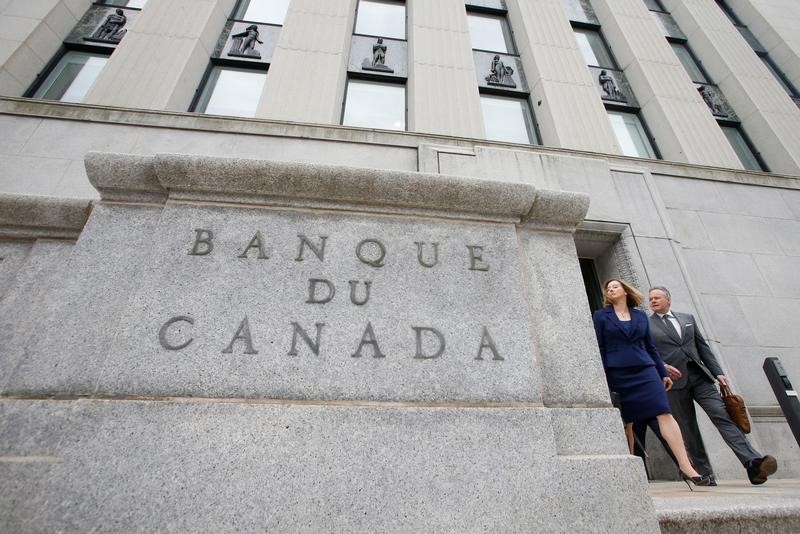 © Reuters. Bank of Canada Raises Rates, Says Move to Neutral Will Be Needed
© Reuters. Bank of Canada Raises Rates, Says Move to Neutral Will Be Needed(Bloomberg) — The Bank of Canada pressed ahead with a fresh interest rate increase, and acknowledged for the first time in more than a decade that it expects to completely remove monetary stimulus from the economy.
The Ottawa-based central bank raised its overnight benchmark rate by a quarter point to 1.75 percent Wednesday, the third hike this year and fifth since it began increasing rates in 2017. More importantly, its statement dropped references to taking a “gradual approach” and added language about the need to bring rates to levels that are no longer expansionary.
“Governing Council agrees that the policy interest rate will need to rise to a neutral stance to achieve the inflation target,” policy makers led by Governor Stephen Poloz said, adding the pace will depend on how Canada’s economy adjusts to higher rates and how global trade policy unfolds.
The statement suggests policy makers — buoyed by the country’s new trade deal with the U.S. and Mexico — are growing increasingly determined to return the nation’s historically low borrowing costs to more normal levels, since a run of strong data suggests the economy is running up against capacity and is healthy enough to cope with rate normalization.
Officials seem to be indicating they expect the current hiking cycle will include at least three more rate increases after Wednesday’s move, given the central bank estimates the neutral rate — a level that is neither stimulative nor contractionary — at anywhere between 2.5 percent and 3.5 percent.
Swaps trading suggests financial markets are anticipating interest rates will rise to the bottom end of the range by the end of next year, where policy makers are expected to stop the cycle.
At the same time, use of the word “stance” to describe neutral may give the Bank of Canada leeway to argue — if it chooses — that something less than 2.5 percent is also non-expansionary. Poloz has said a lot of uncertainty remains around the central bank’s estimate for neutral.
All 23 economists surveyed by Bloomberg predicted the hike.
Despite dropping its reference to moving gradually, the central bank did retain language in its statement that linked the future pace of rate increases to the economy’s adjustment to higher borrowing costs in the face of elevated household debt levels. Before the statement, the market was anticipating another increase by January, followed by a move in the second quarter of next year and another in the second half of 2019.
“In determining the appropriate pace of rate increases, Governing Council will continue to take into account how the economy is adjusting to higher interest rates, given the elevated level of household debt,” the Bank of Canada said. “In addition, we will pay close attention to global trade policy developments and their implications for the inflation outlook.”
Highlights from Statement and MPR
- In its monetary policy report, the Bank of Canada maintains its estimate of an economy running at capacity, with zero output gap (the midpoint of its -0.5% to 0.5% range), and growth “tracking close to potential”
- The bank expects gross domestic product growth of 2.1% in 2018, 2.1% in 2019 and 1.9% in 2020 — with better a composition of growth as exports and business investment pick up
- Potential growth is forecast to average 1.9% over the 2018- 2020 projection
- While wage growth remains moderate, policy makers expect it to pick up in coming quarters
- Housing vulnerabilities are declining after recent regulatory measures and in response to higher rates, though they remain elevated
- Inflation is expected to remain close to the bank’s 2 percent target through 2020
- Bank of Canada bank revises up its outlook for business investment and exports as a result of the UMSCA trade agreement and the recent liquid project approval in British Columbia
- Positive effects from the North American trade deal are being offset by a decline in Canadian oil prices that is hurting terms of trade
- Trade tensions between the U.S. and China have escalated, with a small negative effect on GDP
- Further escalation of this conflict is seen as the biggest risk to global growth
- Investment will also be restrained by “ongoing competitiveness issues and limited transportation capacity”
- The rate statement cites recent financial market volatility, but says “global financial conditions remain accommodative”
- “The Bank will be monitoring the extent to which the USMCA leads to more confidence and business investment in Canada”
Fusion Media or anyone involved with Fusion Media will not accept any liability for loss or damage as a result of reliance on the information including data, quotes, charts and buy/sell signals contained within this website. Please be fully informed regarding the risks and costs associated with trading the financial markets, it is one of the riskiest investment forms possible.
Source: Investing.com



























